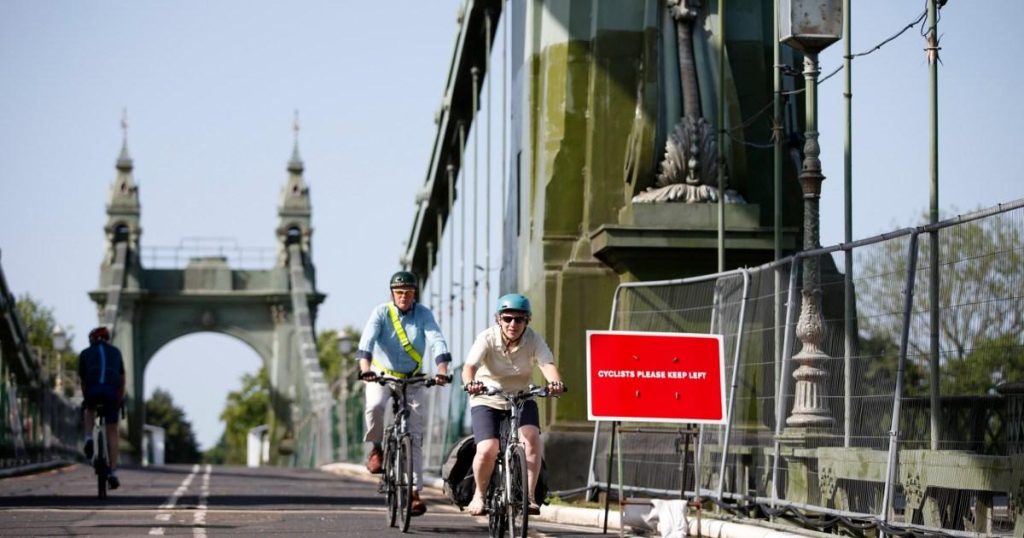The Hammersmith Bridge, a 19th-century landmark in West London, faces a protracted and costly path to full reopening, with estimates suggesting it may not be accessible to motor vehicles until 2035. Originally constructed in 1827 for horse-drawn traffic, the bridge has succumbed to the strains of modern usage, requiring extensive repairs estimated at a staggering £250,000,000. The bridge’s closure to cars, initiated almost six years ago due to cracks in its pedestals, has caused significant disruption and frustration for Londoners. While pedestrians and cyclists were granted access last February, a subsequent collision with a boat carrying football fans further complicated the situation, highlighting the bridge’s vulnerability. The escalating costs and extended timeline for repairs have sparked political debate, with accusations of inaction directed at the previous Conservative government.
The current projected timeline of ten years for completing the necessary repairs paints a bleak picture for commuters and residents who rely on the bridge. Factors such as the ongoing war in Ukraine, which has impacted steel availability, have further exacerbated the challenges. MP Fleur Anderson criticizes the previous government’s perceived lack of urgency, arguing that earlier intervention could have mitigated the current predicament. The delay has allowed unforeseen circumstances to compound the issue, making the task of restoring the bridge increasingly complex and expensive. The rising costs, coupled with the extended timeframe, underscore the significant financial and logistical hurdles facing the project.
The debate surrounding the bridge’s repair extends beyond logistical challenges and encompasses political accountability. Sarah Olney, the Lib Dem MP for Richmond Park, characterizes the previous government’s handling of the situation as a “stain on their legacy,” pointing to the alleged inaction on the repair business case. This inaction, she argues, has contributed significantly to the current predicament. Lord Hendy of Richmond Hill, who has firsthand experience of the bridge’s instability, emphasizes the inherent mismatch between the bridge’s original design and its contemporary usage. The bridge, conceived for a bygone era of horse-drawn carriages, is ill-equipped to handle the demands of modern motor traffic. This fundamental incompatibility lies at the heart of the ongoing structural issues.
Adding another layer of complexity to the situation is the ongoing dispute between local authorities regarding the financial responsibility for the repairs. Hammersmith and Fulham Council, which owns the bridge, is reportedly locked in discussions with neighboring Richmond upon Thames Council and Transport for London (TfL) about how to apportion the substantial costs. The lack of a clear funding plan further contributes to the uncertainty surrounding the project. Lord Hendy stresses the urgent need for these entities to reach a consensus on the bridge’s future usage and funding, highlighting the importance of collaborative decision-making in navigating this complex situation.
The Department for Transport maintains that it is actively engaged with the involved parties, emphasizing its provision of £13 million in funding to date. The establishment of a Hammersmith Bridge Taskforce aims to facilitate communication and progress among stakeholders. This forum provides a platform for discussing the ongoing repairs, potential future steps, and the broader impact on local traffic. While the department’s commitment to collaboration is evident, the significant funding gap and the protracted timeline remain major obstacles.
The Hammersmith Bridge saga exemplifies the challenges of maintaining aging infrastructure in a rapidly changing world. The bridge, a historical landmark that has witnessed centuries of change, now stands as a symbol of the complex interplay between historical preservation, modern demands, and political accountability. The ongoing debate surrounding its repair highlights the need for proactive planning, inter-agency cooperation, and a clear vision for the future of essential infrastructure. The bridge’s fate hangs in the balance, awaiting a decisive plan of action that addresses the multifaceted challenges it presents.




